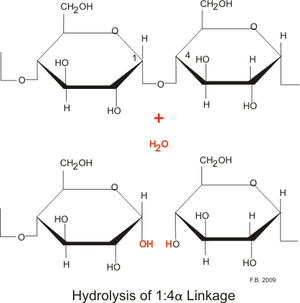Sandbox Reserved 459
From Proteopedia
| Line 23: | Line 23: | ||
---- | ---- | ||
| + | To examine the crystal structure of human salivary amylase, X-ray crystallography was used with a resolution of 1.60 Å. The active site of alpha-amylase contains a trio of acidic groups that do most of the work. Ca2+ is a common <scene name='Sandbox_Reserved_459/Christie_ligand/1'>ligand</scene> for alpha amylase.The Ca2+ ion is bound to Asnl00, Arg158, Asp167, His201 and three water molecules. | ||
<scene name='Sandbox_Reserved_459/Christie_helix/1'>helices</scene> | <scene name='Sandbox_Reserved_459/Christie_helix/1'>helices</scene> | ||
<scene name='Sandbox_Reserved_459/Christie_beta_sheet/1'>beta strands</scene> | <scene name='Sandbox_Reserved_459/Christie_beta_sheet/1'>beta strands</scene> | ||
| - | + | ||
<scene name='Sandbox_Reserved_459/Christie_hydrophobic/1'>hydrophobic residues</scene> | <scene name='Sandbox_Reserved_459/Christie_hydrophobic/1'>hydrophobic residues</scene> | ||
== '''Mechanism of Action''' == | == '''Mechanism of Action''' == | ||
Revision as of 16:07, 4 May 2012
| This Sandbox is Reserved from 13/03/2012, through 01/06/2012 for use in the course "Proteins and Molecular Mechanisms" taught by Robert B. Rose at the North Carolina State University, Raleigh, NC USA. This reservation includes Sandbox Reserved 451 through Sandbox Reserved 500. | |||||||
To get started:
More help: Help:Editing For more help, look at this link: http://www.proteopedia.org/wiki/index.php/Help:Getting_Started_in_Proteopedia
AmylaseIntroductionAmylase is categorized in a class of enzymes known as hydrolases. Hydrolases are enzymes which use water to cleave chemical bonds, usually dividing a large molecule into two smaller molecules. Examples of common hydrolases include esterases, proteases, glycosidases, nucleosidases, and lipases. Hydrolases carry out important degradative reactions in the body. During digestion, lipases hydrolyze lipids and proteases convert protein to amino acids. Hydrolases cleave large molecules into fragments used for synthesis , the excretion of waste materials, or as sources of carbon for the production of energy. Amylase is an enzyme that catalyses the breakdown of starch into sugars. Amylase is present in human saliva, where it begins the chemical process of digestion. Food that contains much starch but little sugar, such as rice and potato, taste slightly sweet as they are chewed because amylase turns some of their starch into sugar in the mouth. The pancreas also makes amylase (alpha amylase) to hydrolyse dietary starch into disaccharides and trisaccharides which are converted by other enzymes to glucose to supply the body with energy. Plants and some bacteria also produce amylase. As diastase, amylase was the first enzyme to be discovered and isolated.
StructureTo examine the crystal structure of human salivary amylase, X-ray crystallography was used with a resolution of 1.60 Å. The active site of alpha-amylase contains a trio of acidic groups that do most of the work. Ca2+ is a common for alpha amylase.The Ca2+ ion is bound to Asnl00, Arg158, Asp167, His201 and three water molecules.
Mechanism of Action
Medical Implications or Possible Applications |

